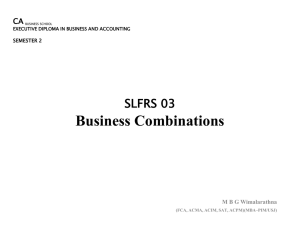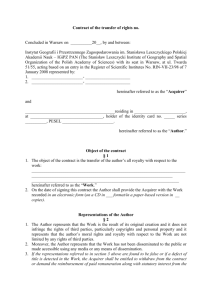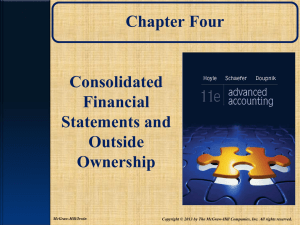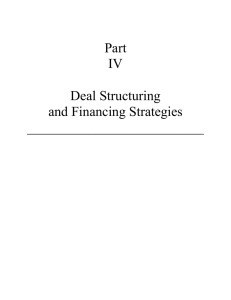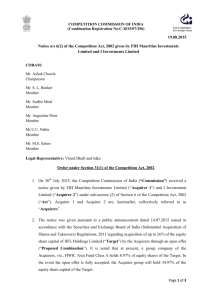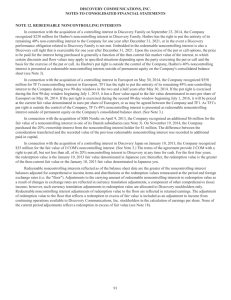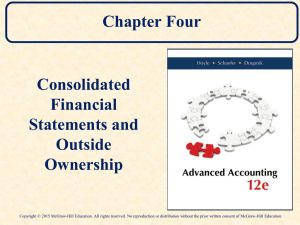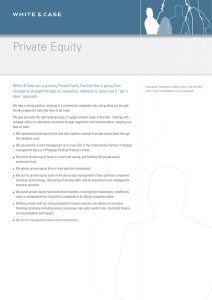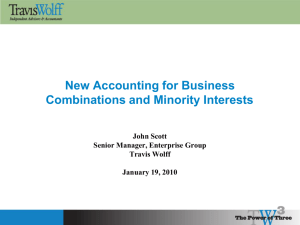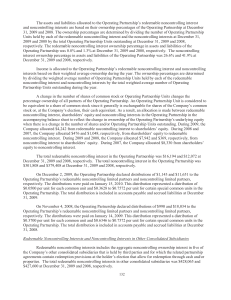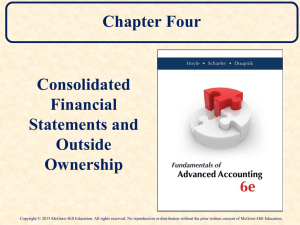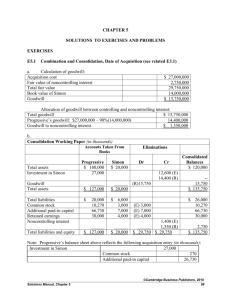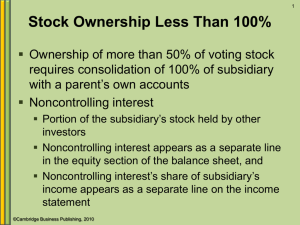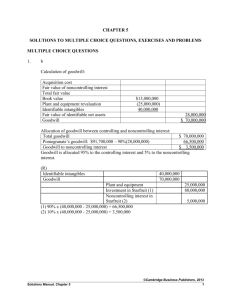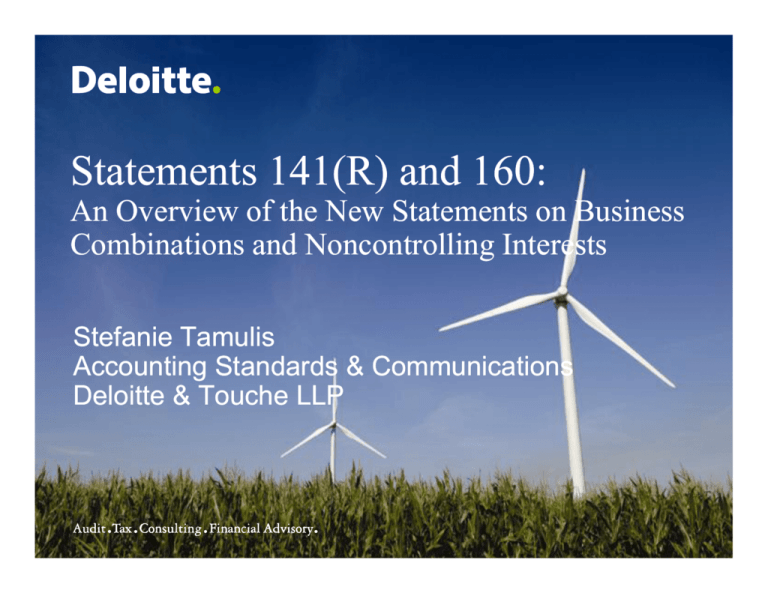
Statements 141(R) and 160:
An Overview of the New Statements on Business
Combinations and Noncontrolling Interests
Stefanie Tamulis
Accounting Standards & Communications
Deloitte & Touche LLP
Background
• Phase One – Statements 141 and 142
– Eliminated poolings
– Eliminated amortization of goodwill
– Created “indefinite-lived intangibles”
• Phase Two – Statements 141(R) and 160
– Joint project with the IASB
– Reconsideration of purchase
accounting guidance
– Addressed accounting for
noncontrolling (minority) interests
Key Objectives
• Develop a single, high-quality standard that can be
used for cross-border financial reporting
• Improve the completeness, relevance, and
comparability of financial information provided
• Simplify the accounting for business combinations
and noncontrolling interests
– Standards developed around basic principles
– Greater convergence with IFRS
Effective Date and Transition
Effective Date:
• U.S. – Statements 141(R) and 160
– Annual periods beginning after December 15, 2008
• IFRS – IFRS 3 (Revised) and IAS 27 (Revised)
– Annual periods beginning after July 1, 2009
Transition:
– Transactions are prospective
– Statement 160’s presentation and disclosure
requirements are retrospective
– No early adoption for U.S.
FASB Statement No. 141(R),
Business Combinations
Key Principles
Recognition Principle:
The acquirer recognizes all of the assets acquired
and all of the liabilities assumed at the acquisition
date
Fair Value Measurement Principle:
The acquirer measures each asset acquired and
each liability assumed at fair value at the
acquisition date
Exceptions to the Principles
Apply other standards, not fair value:
• Same exceptions as Statement 141
–
–
–
–
–
–
Income taxes (Statement 109, FIN 48)
Employee benefits (Statements 87, 106, etc.)
Share-based payment awards (Statement 123(R))
Operating leases (Statement 13)
Assets held for sale (Statement 144)
Reacquired rights (EITF 04-1)
• New exceptions in Statement 141(R)
– Indemnification assets
Significant Changes to Practice
•
•
•
•
•
•
•
•
•
Scope
Definition of a business
Contingencies
Research and development assets (IPR&D)
Income taxes
Indemnification assets
Restructuring costs
Transaction costs
Contingent consideration
Significant Changes to Practice (cont.)
•
•
•
•
•
•
Measurement date for equity securities
Bargain purchases
Partial and step acquisitions
Measurement period
Classification of noncontrolling interests
Acquisitions and dispositions of noncontrolling
interests
• Deconsolidation transactions
Scope
Current Practice:
Statement 141(R):
• Acquisition model (i.e.,
purchase of net assets
that constitute a
business or equity
interests)
• Control model (i.e., any
transaction or event
where an entity obtains
control of a business)
Observation
• Change in scope drove the switch in terminology
from “purchase method” to “acquisition method”
Definition of a Business
Current Practice:
• Definition and related
application guidance is
provided in EITF 98-3.
Must have inputs,
processes, AND outputs
Statement 141(R):
• Definition of a business
is broader and clarified
with additional
application guidance
Contingencies – Initial Measurement
Current Practice:
Statement 141(R):
• Recognized at fair value
if fair value can be
determined
• Otherwise, apply
Statement 5 when fair
value is determinable
• If contractual, measured
at fair value
• If non-contractual,
measured at fair value if
it is more-likely-than-not
that the acquirer has an
asset or a liability
Observation
• If noncontractual and less-likely-than-not, item is not
recognized in the business combination. Post
acquisition, follow other GAAP (e.g. Statement 5)
Contingencies – Subsequent Measurement
Current Practice:
Statement 141(R):
• If initially recognized at • Subsequently measure a
liability at the higher of:
fair value – no guidance
– Its acquisition-date fair
• If initially recognized
value
– The Statement 5
using Statement 5 –
amount
continue to follow
• Subsequently measure
Statement 5
an asset at the lower of:
– Its acquisition-date fair
value
– The best estimate of
its future settlement
amount.
Example - Contingencies
Example of Noncontractual Contingent Liability
• Company A acquires Company B
• Company B has a class action lawsuit regarding
the safety of its products
• The plaintiffs are seeking damages of $1 billion
• Company A concludes that there is a 30% chance
that Company B is liable
• Since < 50% chance of being liable, no liability is
recognized – subsequently follow Statement 5
Research and Development Assets
Current Practice:
Statement 141(R):
• R&D assets that have
no alternative future
use (IPR&D) are
measured at fair value
and immediately
expensed
• R&D assets recognized at
fair value at the acquisition
date
• Classified as indefinitelived until completed or
abandoned
• Subject to Statement 142
impairment testing
• Once completed,
determine useful life and
amortize
Income Taxes
Current Practice:
Statement 141(R):
• Reflect any changes in
the acquirer's
preexisting tax
balances as part of the
business combination
• Reductions of acquired
valuation allowances
recognized first against
goodwill, then
intangible assets, then
in expense
• Reflect any changes in the
acquirer's preexisting tax
balances separate from the
business combination
• Changes in acquired tax
uncertainties and valuation
allowances recorded in tax
expense, even for acquisitions
accounted for under previous
standards
– Amends Statement 109 and FIN
48 and nullifies EITF 93-7
Indemnification Assets
Current Practice:
Statement 141(R):
• Recognition and
• No guidance
measurement follows the
exactly on point
related liability
• Diversity in practice
• Can be an exception to the
recognition and measurement
principles
Observation
• Common examples – Interpretation 48 liabilities and
unrecognized noncontractual contingencies
Restructuring Reserves
Current Practice:
Statement 141(R):
• Only items that meet the
• Recognize planned
definition of a liability
restructuring as
(Statement 146 criteria) at
liabilities assumed
the acquisition date are
• Inconsistent treatment
recognized
for acquirer’s
• Recognize as expenses in
restructuring versus
post-combination period.
acquiree’s restructuring
• Nullifies EITF 95-3 and
aligns accounting with
Statement 146
Transaction Costs
Current Practice:
• Direct costs included
as a component of
purchase price
(e.g. accountants,
attorneys, etc.)
Statement 141(R):
• Exclude from
consideration transferred
• Generally expensed
(except for costs to issue
debt and equity)
Contingent Consideration
Current Practice:
Statement 141(R):
• Generally, recognized as an
additional component of cost
when the contingency is
resolved
• Inconsistent accounting if
based on earnings versus
based on security prices
• Adjust purchase price
indefinitely
• Recognized at fair value at
the acquisition date
• Classify as a liability, equity
or asset
• If equity, do not remeasure
• If asset or liability, measure
at fair value at each
reporting date with changes
recognized in earnings
Observation
• Most arrangements will be classified as liabilities
Acquirer’s Equity Securities
Issued as Consideration
Current Practice:
Statement 141(R):
• Measured as the average
of the price a few days
before and a few days
after terms are agreed to
and announced
• Measured on the
acquisition date
Observation
• This provision may significantly change the amount
recorded for the acquiree if the acquirer’s share price
changes between agreement date and acquisition date
Bargain Purchases
Current Practice:
Statement 141(R):
• Excess allocated pro rata
to goodwill, intangibles
and other long-term
assets
• Only then is an
extraordinary gain
recognized
• Excess of net identifiable
assets over fair value of
consideration recognized
as a gain (not
extraordinary)
• Do not allocate long-term
assets
Observation
• Sometimes occur because of exceptions to the fair
value/recognition principles rather than “true bargains”
Bargain Purchases
Example:
Acquirer pays $180M in cash to acquire 100% of
Target. The fair value of current assets is $100M
and the fair value of long-lived assets is $150M.
Acquirer recognizes:
Current assets
Long lived assets
Gain on bargain purchase
141(R)
Current
$100M
$150M
($70M)
$100M
$80M
--
Partial and Step Acquisitions
Current Practice:
Statement 141(R):
• Fair value only to the
extent acquired
• Measure identifiable
assets, liabilities, and
NCI at 100% fair values
• Noncontrolling interest
recorded at carrying
amount of identifiable
assets
• Generally only
recognize acquirer’s
share of goodwill
• Recognize acquirer’s and
NCI’s shares of goodwill
• Portion previously owned
when control is obtained
is revalued to fair value
with gain or loss
recognized in income
Example - Partial Acquisition
Acquirer purchases 60% of Target’s equity for $160M in
cash. Target’s net identifiable assets: fair value is $50M;
carrying amount is $10M; NCI fair value is $90M.
Acquirer recognizes:
Net identifiable assets
Goodwill
Noncontrolling interest
1($50*60%)+($10*40%)
141(R)
Current
$50M
$200M
($90M)
2$160-($50*60%)
$34M
1
$130M
2
($4)
3
3$10*40%
Measurement Period
Current Practice:
Statement 141(R):
• One-year “allocation
• Still one year period
period” provided to
• Retroactively recognize
gather information
measurement period
needed to measure
adjustments as if the
assets and liabilities
accounting was complete
• Generally, adjustments
on the acquisition date
are accounted for
prospectively as changes
in estimate
Observation
• Prior period financial statements recasted not restated
Differences - 141(R) and IFRS 3 Revised
• Similar exceptions for income taxes, employee
benefits, operating leases, and share-based payment
awards. Use applicable IFRSs
• Definition of control
• Definition of fair value
• Measuring noncontrolling interests
• Subsequent measurement of contingent assets and
liabilities
• Effective date
• Early adoption
FASB Statement No. 160,
Noncontrolling Interests in
Consolidated Financial Statements
Statement 160 Overview
• Applicable to all entities that prepare consolidated
financial statements, except for not-for-profits
• Amends ARB 51
– Carries forward much of the existing
consolidation guidance
Noncontrolling Interests
Current Practice:
• Unclear classification
guidance. Typically
reported in the
mezzanine
Statement 160:
• Classify as equity
• Accounting and presentation
requirements consistent with
equity classification:
– Net income
– Comprehensive income
Observation
• Other accounting guidance may require some
“noncontrolling interests” to be classified outside of
permanent equity (e.g. Statement 150, ASR 268, D-98,
etc.)
Changes in Controlling Ownership Interests
Current Practice:
Statement 160:
• Increases accounted for
by the purchase method
• Decreases accounted for
as equity transactions or
transactions with gain or
loss recognition
• All accounted for as
equity transactions
• No income statement
effect
Observation
• No more SAB 51 gains
Changes in Controlling Ownership Interests
Acquirer acquired Target by buying 60% of its equity. Two
years later, Acquirer purchases the outstanding 40% for
$300M in cash. Target’s identifiable net assets: fair value
is $600M; carrying amount is $520M; carrying amount of
NCI is $208M.
Balance sheet adjustments:
Increase in net identifiable assets
Increase in goodwill
Elimination of NCI
Decrease in APIC
1$300-$208
2($600-$520)*40%
FAS 160
Current
$32M
2
-
$60
3
$208M
$208M
-
$92M
1
3$300-($600*40%)
-
Loss of Control - Deconsolidation
Current Practice:
Statement 160:
• When a subsidiary is
deconsolidated, no
remeasurement of any
retained noncontrolling
investment
• Any retained
noncontrolling investment
is remeasured to fair
value on the date control
is lost
• Remeasurement becomes
part of the gain or loss
Example – Gain on Loss of Control
FAS 160
Cash proceeds
Parent’s retained
noncontrolling investment in Y
Less: Current book value of Y
Gain on Sale
ARB 51
$ 250
$ 250
75
325
(100)
$ 225
25
275
(100)
$ 175
©2008 Deloitte Development LLC
All rights reserved.

